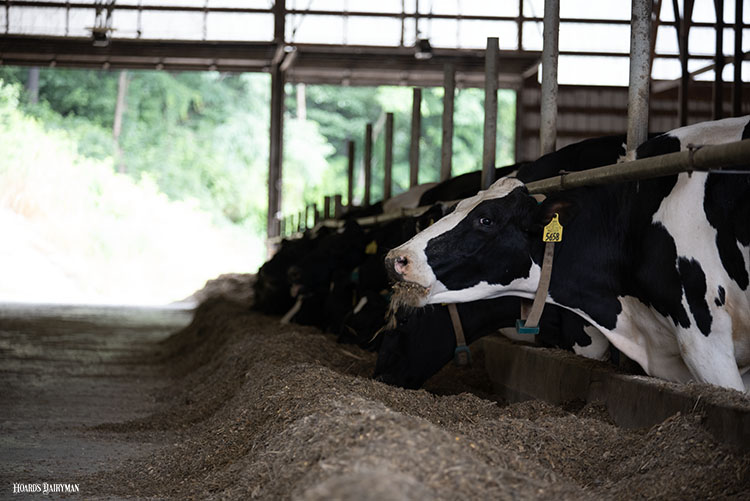
Many complex systems make up the lactating dairy cow. For years, scientists have studied the transition from the dry period to lactation — exposing one puzzle piece at a time to create an image of understanding. As this image comes into focus, dairy producers can create the ideal situation for the transition cow to ensure success.
“This is an important time in production with complex interactions between metabolic, oxidative, and inflammatory statuses,” explained Mingqi Zhang, a dairy researcher at the University of Ghent in Belgium. “We sought to gain insight into how the physiologic status of the cow would impact her health parameters.”
He was joined by Veerle Fievez on “Dairy Science Digest,” a monthly podcast from the University of Missouri, to discuss the balance of energy metabolism and oxidative status of the fresh cow.
Fueling lactation
Fievez described early lactation feed intake as the “holy grail” of transition management. When a fresh cow goes off feed, it has to fuel lactation somehow, so body fat is metabolized to maintain production. Recognizing the process the body goes through to convert fat to usable energy can help us better understand the challenge.
This body fat enters the blood as nonesterified fatty acids or NEFAs. These NEFAs will provide an alternative energy source to the animal, but they cannot be converted to glucose, which is in high demand in early lactation for milk lactose production. To ensure glucose building blocks like oxaloacetate and malate are available to support gluconeogenesis in the liver, they must be withdrawn from the citric acid cycle (TCA cycle). Full oxidation of NEFAs also requires oxaloacetate, so when in short supply, NEFAs are partly pushed toward ketogenesis as an alternative oxidative route.
Ketogenesis generates beta-hydroxybutyrate or BHBA. BHBA, commonly known as ketones or ketone bodies, can be used by the majority of the tissues as an energy source, but they will accumulate when the production rate is exceeding consumption. Ketosis can be observed both clinically or subclinically through cowside tests such as handheld monitors.
The production of BHBA (and ketone bodies in general) often is used as an indicator or warning signal of a high mobilization of body reserves and a potential imbalance between NEFA supply and glucose generation. The metabolic challenge provoked by NEFAs also may create oxidative damage as they are oxidized to be used as fuel.
What the researchers were focused on was attempting to correlate these ketones to antioxidant ability, which is not easily tested, in the fresh cow to determine how the relationship might impact milk production.
“If the cows are off feed, they become short on energy as well as consuming less dietary antioxidants while the building blocks for oxidative damage are increasing,” said Zhang. This lack of balance creates the perfect storm for the fresh cow to fail.
Some cows handle the stress
Oxidative stress runs hand in hand with the transition dairy cow. Free radicals from the conversion of fat to energy track through a cow’s body, resulting in damaged tissues. These reactive oxygen species (ROS) damage protein, lipids, and even DNA.
How effectively the antioxidant system neutralizes the ROS challenge is a cow’s “antioxidant ability.” The Belgium researchers categorized cattle into low antioxidant ability (LAA) and high antioxidant ability (HAA) based on four different blood parameters, including some endogenous enzymes.
Additionally, they tracked the endogenous parameters to see if they could determine which cows are able to control their antioxidant ability by strategically responding to keep the system in balance.
The other side of the scale is the antioxidants received from the diet, such as vitamin E, vitamin C, and selenium, to help balance the equation. Of course, that means the cow has to eat.
The relationship between ketosis, antioxidant status, and milk production
The Belgium team was able to determine that the low antioxidant activity group had significantly higher BHBAs, indicating elevated metabolic activity, perhaps because the LAA herd consumed less feed over the first three weeks in milk.
Indeed, the ketosis group consumed less when compared to the non-ketosis group. “All the LAA animals were subclinically ketotic, but it's not because they were subclinically ketotic that they have low antioxidant ability,” explained Fievez. “It’s really only the LAA herd who have reduced milk production.”
Interestingly, in the high antioxidant ability group of 19 cows, only one exhibited ketosis.
Dairy cows with higher antioxidant capacity in early lactation rarely develop ketosis. Less ketosis has been well-established as an important step to a successful transition into lactation. However, finding that cow in the herd is challenging. Currently, there isn’t a strong, measurable correlation of endogenous controls that could be used as a test cowside.
We’ll have to continue to manage ketosis and antioxidant support separately in the fresh herd.
While not specifically measured in this project, talking with your nutritionist to ensure your transition cows have access to a vitamin and mineral program will support the antioxidant function and serve as a way to neutralize the oxidative damage cows are exposed to. This will help balance the scales in the animal’s favor for successful lactation. Additionally, we can reduce transition ketosis through dietary factors also such as the Goldilocks diet.
To learn more about fresh cow antioxidant activity and management, listen to the “Dairy Science Digest” on your favorite podcast platform or read the full open-access article in the August edition of the Journal of Dairy Science at: www.journalofdairyscience.org.








